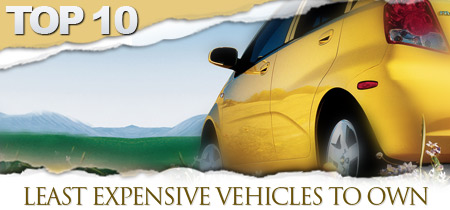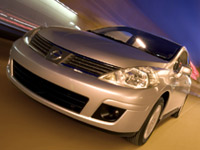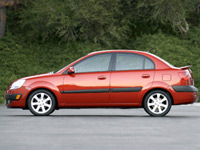|

With small size, fuel efficiency, and fewer amenities,
these are the Top 10 Least Expensive Vehicles to Own
by JEFF ZYGMONT

The cost of owning a vehicle goes beyond the purchase price. Expenses like insurance and maintenance can add up.
To attain absolute rock bottom ownership costs — which still tally more than $30,000 over five years, even for a $10,000 car — a vehicle must be spartan. It must be small and lightweight to maximize fuel economy. And it should skimp on features, so that maintenance and repair costs stay low.
But most of all, it must start life with a sticker price well below even the most affordable luxury cars. A low purchase price holds down insurance premiums, taxes and fees, financing costs, and, especially, depreciation.
That’s why the priciest car on our list of the Top 10 Least Expensive Cars to Own is the tenth ranked Honda Civic DX, which starts at just $15,010.
Our ranking is based on data from Vincentric, a Bloomfield Hills, MI-based research company specializing in automotive cost analysis. Vincentric calculates five-year ownership expenses by estimating cumulative losses from depreciation, interest and opportunity costs, maintenance and repairs, taxes and fees, fuel, and insurance. See end of story for explanations of each expense.
 |
2008 Nissan Versa |
The vehicles on our list are relatively inexpensive, but their value is rising in the current economy, especially as gasoline prices climb. Autodata, which tracks sales for the auto industry, reports that overall vehicle sales dropped 8 percent in the first quarter of 2008. But the small-car segment actually grew by 3 percent during that down period.
If small-car demand continues to grow, ownership costs could decrease even more: Higher prices for economical used cars will keep new-vehicle depreciation in check.
“It's always a matter of supply and demand,” says David Wurster, Vincentric's president. “As people want more of these vehicles, they vote up their price.”
A good resale value is critical to total ownership cost because depreciation is the greatest single part of the total. Cars with lower depreciation rates (higher resale values) will require lower total ownership expenses than peers in the same price group or model segment. Six models on our list incur higher fuel expenses, but only because depreciation takes fewer dollars from budget-priced cars to begin with.
“Depreciation is the one cost that most people forget about,” says John Paul, manager of public affairs for AAA of Southern New England. “They look at all the other costs, but they forget how much a car is going to depreciate, even over the first year.”
To gauge deprecation rates when shopping for a new car, Paul suggests researching used-car prices for models on your list. Comparing used prices to the prices of new models shows approximately how much each vehicle depreciates.
“Sometimes the cheapest car isn't always the best deal, especially when it comes time to trade it in,” Paul says.
An automotive company’s reputation can also indicate how well a vehicle holds its value.
“The vehicles with very good reputations for quality are going to continue to do best,” Vincentric’s Wurster says. “That's why you see Toyotas and Hondas doing well year after year. They have good reputations.”
Indeed, the two Hondas on our list depreciate much less than most other models in the top 10. The Honda Fit makes the No. 2 spot on the strength of its low, 58 percent depreciation rate over five years. With a 62 percent depreciation rate, the Honda Civic DX sneaks onto the list at No. 10, even though it has a high starting price compared to other models in the ranking.
That's not accidental. Recognizing the allure of low depreciation, Honda pursues a strategy aimed at maintaining high resale rates.
“It's a very long-term outlook of protecting the brand by protecting resale value,” says Honda spokesperson Chris Naughton.
 |
2008 Kia Rio |
The pillars of that program include striving for high quality and durability so its models will remain desirable even after with lots of miles. Honda avoids building more cars than it can sell and adjusts its factory output to match consumer demand, Naughton says. Honda avoids selling to car-rental and commercial fleets. Both strategies prevent over-supplying the market, which depresses used-car prices. Balancing supply with demand negates a need for sales incentives, which reduce used-car values by reducing new-car values.
“We avoid at all costs being put in the position of stress merchandising,” Naughton says.
Korean automakers Hyundai and Kia each have one vehicle in the ranking — the Hyundai Accent places fifth and the Kio Rio seventh. But the brands aren’t as well regarded as Honda or Toyota, which likely contributes to their high depreciation rates — 77 percent for the Accent and 78 percent for the Rio.
Another Korean-made vehicle, the American-branded Chevrolet Aveo5, made the third spot on the list and also has a high depreciation rate, at 73 percent. The Dodge Caliber SE, in sixth place, and Chevrolet Cobalt LS, in eighth, are the only other domestic models in the ranking.
Five of the least-expensive-to-own vehicles hail from Japan, including the top-ranked Toyota Yaris Liftback, which carries a five-year predicted cost of ownership of $30,820.
Models with attractive low depreciation rates exist in all vehicle categories. But if being frugal takes priority above all other automotive concerns, consider one of the 10 vehicles on this list. In the slideshow you’ll find individual model descriptions along with Vincentric’s projected total cost of ownership after five years, including a breakdown of six components that make up that total.
All are 2008 base models. The manufacturer suggested retail price (MSRP) and ownership costs shown with each model apply only to the most basic version of the vehicle. That usually means it has a five-speed manual transmission. If you add equipment or move up trim levels, ownership costs typically increase accordingly.
Cost estimates are based on prices from March 2008. Interest expenses assume a five-year loan at current rates, with a 15 percent down payment. Opportunity costs consider what owners would have earned if car expenses were placed into certificates of deposit instead. Insurance costs are for a typical driver under age 65 with a clean record. Depreciation assumes the vehicle is disposed of in a private party transaction. To compute fuel costs, Vincentric used a five-month weighted pump-price average. Each model's five-year cost of fuel is calculated by using EPA fuel-economy ratings published in the EPA's 2008 Fuel Economy Guide.
Visit ForbesAutos.com to see the slideshow with the full list of the 10 least expensive vehicles to own. |